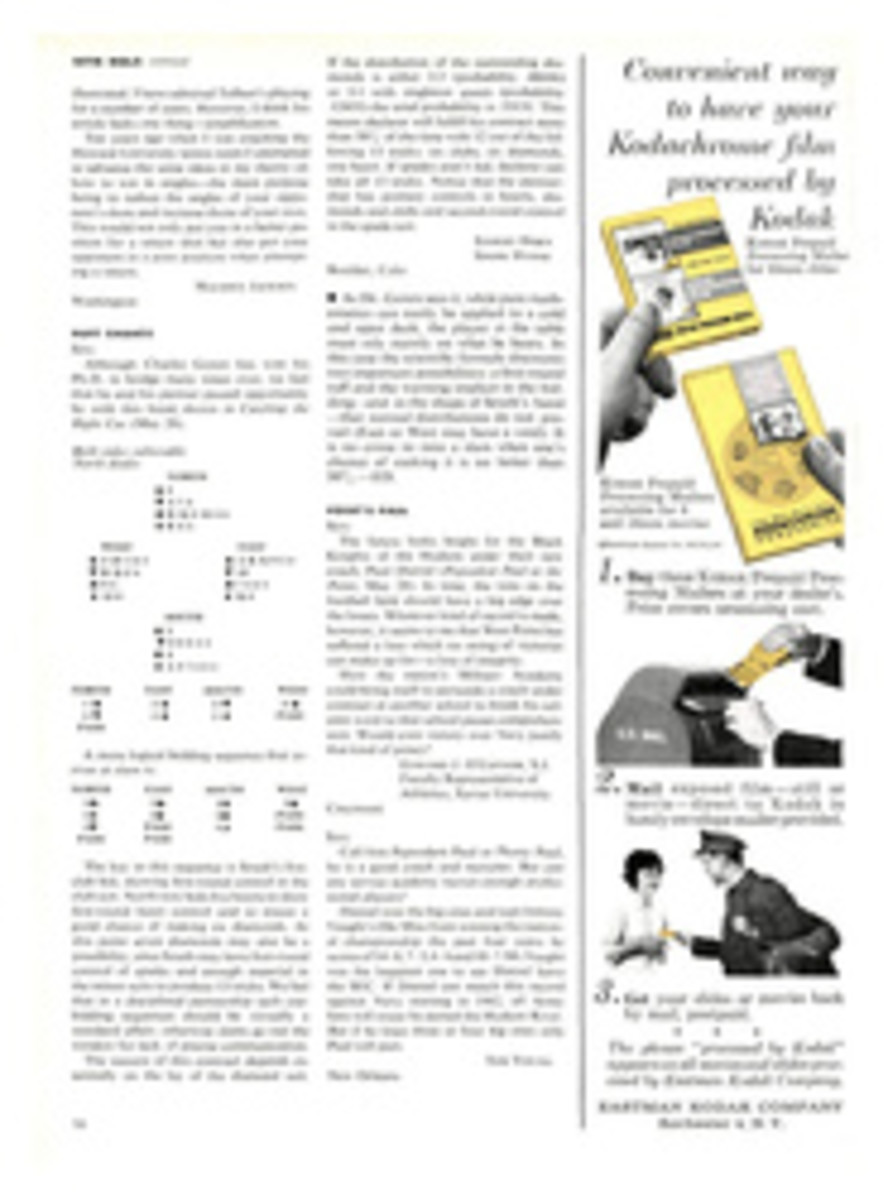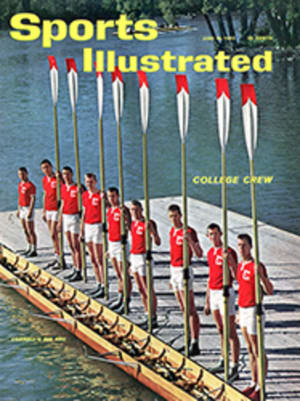
To win, you need a guy who gives
You can't live onpromises," says Coach Fil Leanderson of the University of Washington,"and you can't live on history. It's what you're doing right now thatcounts."
As far asLeanderson and 12 other of the nation's top rowing coaches are concerned, rightnow means this Saturday, when all their crews will compete in the singlebiggest rowing event of the year, the Intercollegiate Rowing Associationchampionship on New York's Onondaga Lake. With history and promises bothpulling pretty strongly for them, Leanderson's largely sophomore Huskies areentering that race fully confident that they'll win—and there is at least afair chance that they will.
There is at thesame time at least a fair chance that any one of a number of other crews willdo the same thing in this punishing three-mile race which is at once the firstand the final meeting of its kind in the season. This is the race for which allof them have been pointing; this is the race all of them want to win. Navy, asperennially potent a threat on collegiate lakes and rivers as it is on theglobal high seas, could pull clear of the snags and crabs that have beendogging it all season and realize at last the promise of its potential.Cornell's Big Red, newly uniformed for battle in shirts that reflect itsnickname (see cover), might at last find a way to shake off Joe Burke'shigh-stroking Pennsylvanians, who have cheated it of victory in cliffhangerfinishes every time the two have met. Perm's own chances look good, provided itcan sustain over the long pull the unbelievably high beats (36 to 40 strokesper minute) that it has used to win and tie shorter races.
Still-unknownquantities as measured against any of these eastern crews are the big threatsfrom the West: Washington's cocky Huskies and California's determined GoldenBears, the defending champions. The Bears will be aiming for their thirdstraight IRA win.
As seasons go,this has been a mediocre one for California, but every year actually is a bigone for this school, which launched its first crew in 1870, a year after thecollege was founded. In and around the campus at Berkeley there is no greatconcern over defeats that occurred earlier in the season. The big race is stillto be rowed, and if the crew is not on top of it this year, the feeling goes,it certainly will be by next. Year after year California's eager-beaver coach,Jim Lemmon, works patiently to that end.
The soft sell
Few if anyintercollegiate sports have less promising raw material to work with than crew,particularly in the West. Like his famed predecessor, Ky Ebright, California'sLemmon starts sifting the ore the moment it is dumped on campus. On the daycollege opens and the freshmen arrive, Lemmon ships his freshman coach, StanShawl, and a platoon of knowing crewmen off to the registration line with apiece of chalk and a notebook. They put a mark on the wall six feet above thefloor, then collar anybody who measures up to it. "These kids are nervousabout starting college and tired of standing in line," says Lemmon, "sowe have to be tactful. After all, this is a sales proposition." The pitchis soft sell: How tall are you? How much do you weigh? Are you going out foranother sport? And if not, why not crew?
Lemmon's bird dogskeep hands off boys who are prepackaged for another Cal sport."Sometimes," says the coach, "a kid will say he's going out forbasketball or football, and by the way he talks we know they're counting onhim. But quite often he'll say, 'Yeah, I'm going out for basketball.' I'll askhim where he played and he'll give some little high school. First string? 'No,third." Has he talked to the basketball coaches yet? 'Well, no, not yet.'You know very well he's not going to play basketball here, so you start talkingup crew.'' Occasionally Lemmon tips off the basketball people on exceptionallytall boys who pass through the line. In fact, he spotted a tall kid namedDarrall Imhoff a few years ago and referred him to Pete Newell, then basketballcoach and now athletic director. Imhoff became an All-America center.
Raw material inhand, Jim Lemmon sets quickly to work. The day after registration, he signs thenew men up, issues them sweat clothes and takes them on a tour of the KyEbright boathouse to let them soak up some tradition. "I want them to seewhat they're pointing for." There is plenty to see: pictures of theOlympians and other Cal champions, crew shirts gathered from the vanquished,scrapbooks full of past glories and, of course, the shells themselves. SaysLemmon fondly: "Their eyes are like saucers the first time they see thosebig old eights."
Next day thefreshmen get their first taste of rowing. In a big scow, eight men to a side,they chop at the water with the unfamiliar oars while Lemmon—like an ancientgalley master—paces between the rows, issuing instructions. "The firststroke is the worst one you'll ever take, I tell them. It certainly is theworst-looking. But the scow is a fine place to learn basic form. It doesn't tipor roll, and you can teach lots of boys at once. They spend their first twoweeks in the scow, putting in 20 to 30 minutes a day there and 10 to 15learning the stroke on shore. Then I put them out gradually into a shell.That's an experience." In the slim, tipsy shells progress is painfullyslow. Yet by the end of the eight-week fall workout the boys can go through themotions of rowing. More important, they can move the boats, so Lemmon holds arace. "We get six or seven crews out there, and it's a riot. They get soexcited you'd think it was the Olympics. They jump seats, catch crabs and bumpinto each other." Somehow, somebody crosses the finish line. Lemmon's firstreaction, as he surveys his freshman lineup, is always, "My God, I'll haveto race with these guys?" "But then," he says, "I remember thatthey've improved from zero knowledge to a point where they can compete—in justtwo months. That's fantastic."
In February, whenspring semester begins, Lemmon again culls the registration lines, looking foradditional freshmen to supplement the 40 or so who decide to return. The crewshit the water the day after classes start. Workouts are increased to six days aweek (plus Sunday before a big race), and by the end of the season the crewswill have rowed halfway to Hawaii. Some of the freshmen are put back in thescow, but most are now ready for full-time duty in the shells. Varsity andjayvee oarsmen are shifted from back to front and side to side in a relentlessgame of musical oars. Coxswains and strokes are tested with one crew, thenanother, to see what makes what boat go fastest. Occasionally the rightcombination clicks smoothly and swiftly into place; normally the jugglingcontinues up to and through the early races. If the juggling costs Cal avictory, as it did against Long Beach State this spring, that's too bad. Itwill pay off later on.
Lemmon-coachedcrews are not known for smooth style. "We row rough—at least by normalstandards," says Jim. "We get the job done with brute strength andawkwardness. There are accepted ways of executing the stroke cycle, But theyaren't right for everyone. You can't fit an oarsman into a preconceivedpattern. What matters is not how he looks but how efficiently he performs. Ifyou have the material and the proper attitude you can win races with anystyle."
The joy of it
Up in the North,Lemmon's appraisal is echoed and amplified by his old rival. "Inrowing," says Fil Leanderson, "you need a guy who gives for the joy ofit, not a guy who correlates what he gives with what he gets." ByLeanderson's own admission, the guy who may have given most to Washington'ssuccess this year is a guy who has not even gotten a seat in the varsity crewfor his pains. He is frustrated, furious, crew-happy Bill Flint, the stroke ofthe Washington junior varsity boat, whose continuous hot breath has spurred thevarsity to ever better effort.
"You can rowhour after hour," says Leanderson, "but if you don't have competition,all you're doing is slogging along. To have a good varsity, you've got to havea good jayvee." In race after race during practice Flint has stroked theHusky jayvees into near victory over the varsity with less than a quarter of alength separating the boats at the finish. A fierce competitor, he woulddoubtless be stroking the varsity boat himself if an even fiercer competitorwere not already in the seat. Varsity stroke Jerry Johnsen was the leader ofWashington's championship freshmen crew of 1961. "He has the kind ofconfidence that gives confidence to others." says his former freshmancoach. "You could spot it the first time he sat in a boat. He didn't justsit there and slide his tongue out of one side of his mouth and start pulling.Jerry raced with his head from the very start. He's the kind of kid who giveseven a coach confidence."
No letup
Despite the lossof a boatload of seniors from last year, the Flint-Johnsen rivalry has sparkedwhat Leanderson thought would be a long season of sophomore rebuilding into asuddenly successful campaign for all the Huskies. It began with an easy,expected victory over Oregon State and was followed two weeks later by anunexpected length-and-a-half victory over California. In a triangular meet withthe University of British Columbia and UCLA at Seattle a week later, the Huskyvarsity breezed home easily with a time of 6:14.5. The Flint-stroked jayveeswon even more easily and posted better time—6:12.3. At Long Beach on May 19 thejayvees again won easily, posting a time of 6:16, one second better than thecourse mark. Immediately the varsity went out and bettered the jayvees' time by4.2 seconds, a fact that still brings anger to Bill Flint's voice when thesubject is mentioned.
"We shouldhave beaten the varsity's time easy," he says. "In that race we wentacross the line at 26; we weren't even pushed, not even a little bit."
In day-to-day timetrials the varsity has shaded the jayvees three times out of four and therewill be no letup in this intramural scrapping until race day on Onondaga Lake.Leanderson, a naturally reticent man, is in no haste to lavish praise on hiscrews, but there is a coach's implied superlative when he speaks of them:"There's nothing in the log book that says this crew is real fast. The onething we can say is they're consistent, and when you get consistency you getconfidence."

